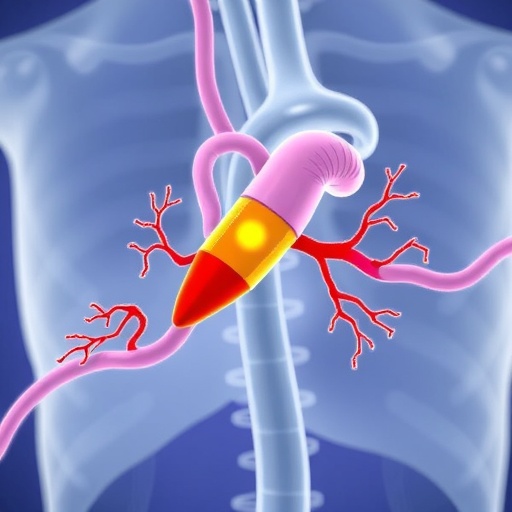Cardiovascular disease remains the leading cause of mortality across the globe, accounting for a staggering proportion of deaths each year. In Europe alone, over 40 percent of all fatalities are linked to cardiovascular conditions, underscoring the urgent need to unravel the multifaceted underlying mechanisms that drive this global health crisis. While traditional risk factors such as hypertension and elevated cholesterol have been extensively studied for decades, these alone do not fully explain the prevalence and severity of cardiovascular diseases observed in the population. A groundbreaking study led by researchers at the University of Graz and Graz University of Technology is now shedding light on a less explored but crucial biochemical player—homocysteine—and its direct impact on vascular function, specifically the stiffness and elasticity of the aorta.
The aorta, as the largest artery in the human body, plays an indispensable role in maintaining effective blood circulation by dynamically contracting and expanding with each heartbeat to propel oxygen-rich blood. Its biomechanical integrity is therefore critical in ensuring cardiovascular health. Dysfunction of the aortic wall can initiate a cascade of detrimental events leading to a variety of cardiovascular diseases, including atherosclerosis, where arterial walls thicken and lose their flexibility. In this context, the team led by biomechanical expert Gerhard A. Holzapfel, molecular bioscientist Oksana Tehlivets, and Francesca Bogoni from the biomechanical institute has embarked on an investigative journey to understand how elevated homocysteine levels influence aortic mechanics, independent of traditionally studied factors such as cholesterol.
Homocysteine, an amino acid derivative produced as an intermediate during methionine metabolism, is increasingly recognized for its pathological potential when accumulated in the bloodstream. Normally, homocysteine is rapidly broken down and cleared; however, disruptions in its metabolism can lead to elevated circulating concentrations. Aging, dietary habits rich in fats, and sedentary lifestyles are contributing factors to this buildup, particularly among older adults. The team’s research, utilizing a sophisticated rabbit model of atherosclerosis, reveals that this “cell poison” triggers pronounced stiffening of the aortic wall, significantly reducing its natural elasticity and altering its biomechanical response to physiological forces.
The scientific approach deliberately controlled for cholesterol presence, isolating homocysteine’s effect on vascular tissues. Prior understanding positioned cholesterol as a primary culprit in arterial stiffness and atherogenesis, but this study boldly highlights that homocysteine alone can induce biomechanical alterations that predispose vessels to disease. This represents a paradigm shift in cardiovascular pathology, emphasizing the need to reassess risk stratification models and preventive strategies to incorporate this critical metabolic marker. The animal tissue samples examined provided compelling evidence that homocysteine’s accumulation results in remodeling of the extracellular matrix, a fundamental component conferring elasticity to soft biological tissues.
Mechanistically, the study elucidates how homocysteine impacts the equilibrium state of the aortic tissue by inducing inelastic effects, such as collagen cross-linking and elastin degradation. These molecular-level modifications translate into macro-scale biomechanical deficits observed experimentally, contributing to a stiffer arterial wall that cannot effectively absorb pulsatile blood flow energy. Such impairment creates a feedback loop, escalating stress on the heart and increasing vulnerability to hypertension and ischemic events. The research employs advanced experimental techniques combined with computational modeling to capture these phenomena, offering a comprehensive biomechanical profile deeply informative for both clinical and bioengineering applications.
One of the most groundbreaking aspects of this research lies in its potential translational capacity. Understanding how homocysteine elicits these pathophysiological changes opens avenues for the development of targeted therapeutic interventions aimed at restoring or preserving aortic compliance in at-risk populations. This could ultimately translate into novel pharmaceutical agents or lifestyle modification programs explicitly designed to modulate homocysteine metabolism alongside traditional treatment regimens. Such advancements would enhance the precision of cardiovascular disease management, mitigating progression before irreversible vascular damage ensues.
Equally significant is the interdisciplinary collaboration underpinning this study, integrating expertise spanning molecular biosciences, biomechanics, and clinical medicine. Partners from the Medical University of Graz contributed vital knowledge regarding vascular pathology, allowing for the extraction and analysis of physiologically relevant tissue samples. The Austrian Science Fund (FWF) and BioTechMed-Graz provided essential financial support, highlighting the importance of robust funding mechanisms to propel high-impact biomedical research. This cooperative model exemplifies the future direction of cardiovascular research, combining cutting-edge technology and multifaceted expertise to address complex health challenges.
The implications of this work extend beyond the specific context of atherosclerosis. Since arterial stiffness is implicated in a spectrum of cardiovascular maladies, including heart failure and stroke, the insights garnered may have broad relevance. Further studies are anticipated to explore homocysteine’s role in human subjects and diverse vascular beds, evaluating whether similar biomechanical remodeling occurs and how it correlates with clinical outcomes. Such research will be critical in validating these findings and framing new paradigms in cardiovascular risk assessment.
While the metabolic origin of homocysteine is well known, its multifarious effects on vascular function demand increased attention from both the research community and healthcare providers. This investigation makes a compelling case for incorporating homocysteine screening into routine cardiovascular health assessments, especially in populations exhibiting risk factors such as aging or lifestyle-associated metabolic dysfunction. Early detection and intervention could forestall progression to severe vascular complications, improving morbidity and mortality statistics substantially.
Moreover, the data contribute valuable insights toward the ongoing debate regarding the relative contributions of biochemical versus mechanical factors in vascular disease pathogenesis. By highlighting homocysteine’s direct mechanobiological influence on the aortic wall, this research situates amino acid metabolism as a crucial element in vascular homeostasis disruption. It challenges researchers to rethink the complexity of vascular health not only through lipid-centric lenses but also through the interplay of metabolic and biomechanical factors.
In summary, the pioneering work conducted by Tehlivets, Holzapfel, Bogoni, and their colleagues underscores that elevated homocysteine levels are a key mediator of aortic stiffening, independent of cholesterol influence. Through meticulous experimental studies and integrative biomechanical analysis, they have illuminated novel pathways driving cardiovascular disease progression. These findings propel forward our understanding of vascular biology and highlight new targets for intervention, signaling a transformative advance within cardiovascular medicine and biomaterials research.
Subject of Research: Animal tissue samples
Article Title: Homocysteine leads to aortic stiffening in a rabbit model of atherosclerosis
News Publication Date: 1-Jul-2025
Web References: http://dx.doi.org/10.1016/j.actbio.2025.06.003
References:
Bogoni et al. Homocysteine leads to aortic stiffening in a rabbit model of atherosclerosis. Acta Biomaterialia, 2025.
Image Credits: TU Graz
Keywords: Cardiovascular disease, aortic stiffness, homocysteine, atherosclerosis, biomechanics, amino acid metabolism, vascular elasticity, experimental study, biomechanical remodeling, arterial compliance, extracellular matrix, vascular pathology
Tags: aorta stiffness mechanismsaortic wall dysfunctionatherosclerosis developmentbiochemical contributions to cardiovascular conditionsbiomechanics of the aortacardiovascular disease researchcardiovascular mortality causesglobal health crisis in cardiovascular diseaseGraz University research studyhomocysteine impact on vascular healthimportance of aortic elasticityrole of traditional risk factors





